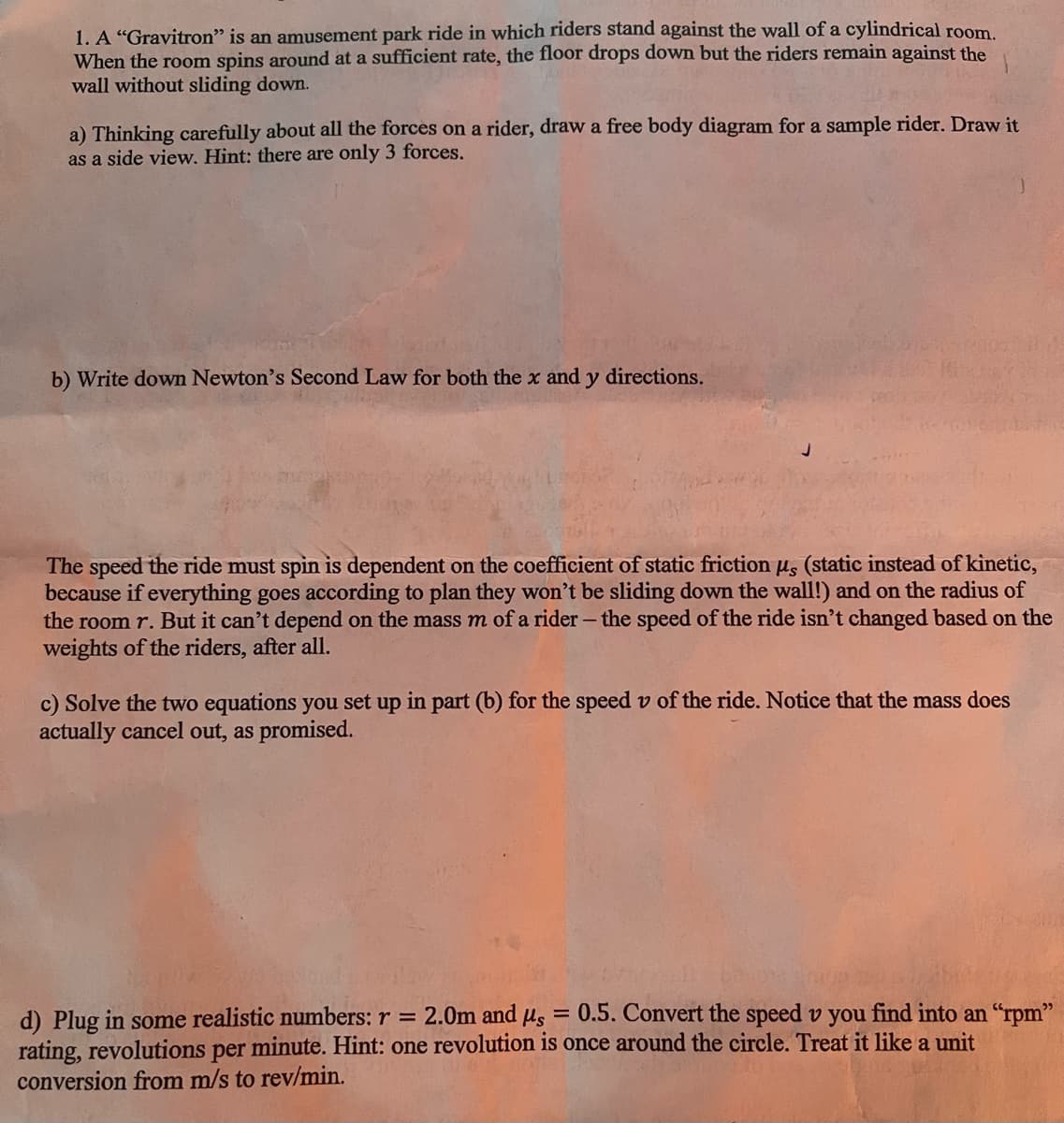1. A "Gravitron" is an amusement park ride in which riders stand against the wall of a cylindrical room. When the room spins around at a sufficient rate, the floor drops down but the riders remain against the wall without sliding down. a) Thinking carefully about all the forces on a rider, draw a free body diagram for a sample rider. Draw it as a side view. Hint: there are only 3 forces. b) Write down Newton's Second Law for both the x and y directions. The speed the ride must spin is dependent on the coefficient of static friction us (static instead of kinetic, because if everything goes according to plan they won't be sliding down the wall!) and on the radius of the room r. But it can't depend on the mass m of a rider - the speed of the ride isn't changed based on the weights of the riders, after all. c) Solve the two equations you set up in part (b) for the speed v of the ride. Notice that the mass does actually cancel out, as promised. = Plug in some realistic numbers: r = 2.0m and us 0.5. Convert the speed v you find into an "rpm" ting, revolutions per minute. Hint: one revolution is once around the circle. Treat it like a unit onversion from m/s to rev/min.
1. A "Gravitron" is an amusement park ride in which riders stand against the wall of a cylindrical room. When the room spins around at a sufficient rate, the floor drops down but the riders remain against the wall without sliding down. a) Thinking carefully about all the forces on a rider, draw a free body diagram for a sample rider. Draw it as a side view. Hint: there are only 3 forces. b) Write down Newton's Second Law for both the x and y directions. The speed the ride must spin is dependent on the coefficient of static friction us (static instead of kinetic, because if everything goes according to plan they won't be sliding down the wall!) and on the radius of the room r. But it can't depend on the mass m of a rider - the speed of the ride isn't changed based on the weights of the riders, after all. c) Solve the two equations you set up in part (b) for the speed v of the ride. Notice that the mass does actually cancel out, as promised. = Plug in some realistic numbers: r = 2.0m and us 0.5. Convert the speed v you find into an "rpm" ting, revolutions per minute. Hint: one revolution is once around the circle. Treat it like a unit onversion from m/s to rev/min.
College Physics
10th Edition
ISBN:9781285737027
Author:Raymond A. Serway, Chris Vuille
Publisher:Raymond A. Serway, Chris Vuille
Chapter4: The Laws Of Motion
Section: Chapter Questions
Problem 32P: Two blocks of masses m1 and m2 (m1 m2) are placed on a frictionless table in contact with each...
Related questions
Question
Please help me with this question : one questions with 3 parts in the image below

Transcribed Image Text:1. A "Gravitron" is an amusement park ride in which riders stand against the wall of a cylindrical room.
When the room spins around at a sufficient rate, the floor drops down but the riders remain against the
wall without sliding down.
a) Thinking carefully about all the forces on a rider, draw a free body diagram for a sample rider. Draw it
as a side view. Hint: there are only 3 forces.
b) Write down Newton's Second Law for both the x and y directions.
The speed the ride must spin is dependent on the coefficient of static friction µs (static instead of kinetic,
because if everything goes according to plan they won't be sliding down the wall!) and on the radius of
the room r. But it can't depend on the mass m of a rider - the speed of the ride isn't changed based on the
weights of the riders, after all.
c) Solve the two equations you set up in part (b) for the speed v of the ride. Notice that the mass does
actually cancel out, as promised.
d) Plug in some realistic numbers: r = 2.0m and us = 0.5. Convert the speed v you find into an "rpm"
rating, revolutions minute. Hint: one revolution is once around the circle. Treat it like a unit
per
conversion from m/s to rev/min.
Expert Solution
This question has been solved!
Explore an expertly crafted, step-by-step solution for a thorough understanding of key concepts.
This is a popular solution!
Trending now
This is a popular solution!
Step by step
Solved in 2 steps with 2 images

Knowledge Booster
Learn more about
Need a deep-dive on the concept behind this application? Look no further. Learn more about this topic, physics and related others by exploring similar questions and additional content below.Recommended textbooks for you

College Physics
Physics
ISBN:
9781285737027
Author:
Raymond A. Serway, Chris Vuille
Publisher:
Cengage Learning

College Physics
Physics
ISBN:
9781938168000
Author:
Paul Peter Urone, Roger Hinrichs
Publisher:
OpenStax College

Principles of Physics: A Calculus-Based Text
Physics
ISBN:
9781133104261
Author:
Raymond A. Serway, John W. Jewett
Publisher:
Cengage Learning

College Physics
Physics
ISBN:
9781285737027
Author:
Raymond A. Serway, Chris Vuille
Publisher:
Cengage Learning

College Physics
Physics
ISBN:
9781938168000
Author:
Paul Peter Urone, Roger Hinrichs
Publisher:
OpenStax College

Principles of Physics: A Calculus-Based Text
Physics
ISBN:
9781133104261
Author:
Raymond A. Serway, John W. Jewett
Publisher:
Cengage Learning

Physics for Scientists and Engineers with Modern …
Physics
ISBN:
9781337553292
Author:
Raymond A. Serway, John W. Jewett
Publisher:
Cengage Learning

Physics for Scientists and Engineers: Foundations…
Physics
ISBN:
9781133939146
Author:
Katz, Debora M.
Publisher:
Cengage Learning

Physics for Scientists and Engineers, Technology …
Physics
ISBN:
9781305116399
Author:
Raymond A. Serway, John W. Jewett
Publisher:
Cengage Learning